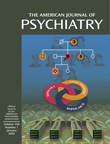To the Editor: Shitij Kapur, M.D., Ph.D., F.R.C.P.C., and Philip Seeman, M.D., Ph.D., F.R.S.(C.), seemed to suggest in their article
(1) that antipsychotic drugs that have atypical properties have more rapid rates of dissociation from dopamine D
2 receptors than those with typical properties. However, this conclusion is incompatible with their own report
(2) that sertindole, which most certainly is an atypical antipsychotic drug because of its very low propensity to cause extrapyramidal symptoms, has the same k
off as haloperidol, the prototypical typical neuroleptic drug. Despite this clear failure, their theory might have had credibility if they had offered as proof even one atypical antipsychotic drug that had been developed on the basis of this theory. To my knowledge, they have not done so. By contrast, risperidone, olanzapine, quetiapine, ziprasidone, and iloperidone, all clearly atypical antipsychotic drugs, were explicitly selected for clinical development on the basis of the “serotonin 5-HT
2A/D
2 hypothesis”that Drs. Kapur and Seeman reject and were then shown to be atypical antipsychotics in both basic research models and clinical studies. In addition to the atypical antipsychotic drugs mentioned, there are at least a half dozen other agents of diverse chemical classes selected on the basis of the 5-HT
2A/D
2 hypothesis during their early development. Most people engaged in drug development agree that a valid theory should be capable of generating new chemical entities.
It has been shown clearly by my colleagues and me
(3) and by others
(4) that the combination of 5-HT
2A and D
2 receptor blockade has an important influence on the release of dopamine in the limbic system, striatum, and cortex. The effect of dopamine release in the limbic system is important for the antipsychotic activity of these compounds, while the effect in the striatum is important for the drugs’ low level of extrapyramidal symptoms. The drugs’ effect in the cortex is likely to be relevant to their ability to improve cognition and negative symptoms and, perhaps indirectly, their antipsychotic effect as well by means of cortical control of subcortical dopamine release. Given the emphasis by Drs. Kapur and Seeman on the importance of their theory regarding the release of endogenous dopamine in displacing antipsychotic drugs from dopamine receptors, it is extremely difficult to understand how they could reject one of the most important determinants of the release of dopamine in the terminal regions of the limbic system, striatum, and cortex as being important to the actions of atypical antipsychotic drugs. Indeed, at one point, Drs. Kapur and Remington
(5) strongly supported the importance of 5-HT receptor antagonism in the atypicality of clozapine and related compounds.

